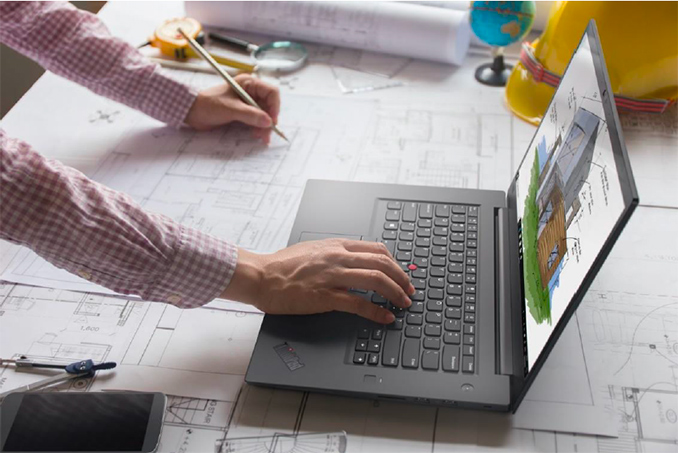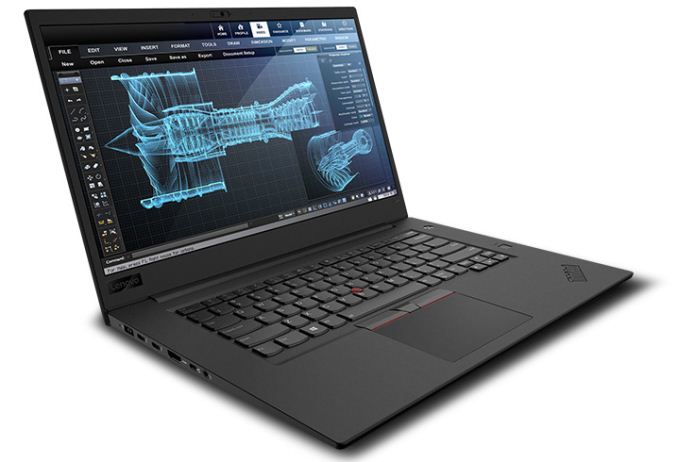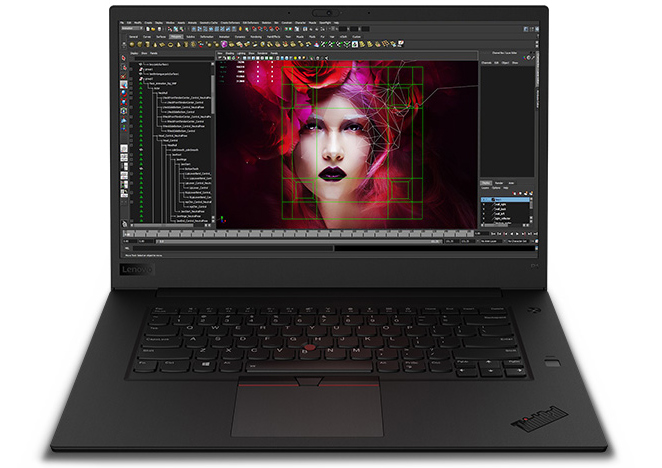Lenovo's Halo: The ThinkPad X1 Extreme Announced
by Anton Shilov on August 30, 2018 2:30 PM EST
Lenovo on Thursday introduced its ultra-thin ThinkPad X1 Extreme laptop aimed at business users who are also interested in gaming and multimedia applications. The new notebook has a 15.6-inch display and is basically a version of the ThinkPad P1 mobile workstation with a gaming-grade discrete GPU and additional enhancements aimed at the target audience. Meanwhile, a ThinkPad is still a ThinkPad, with all the business/enterprise-related advantages of the series.
The Lenovo ThinkPad X1 Extreme is based on Intel’s Core i7 or Core i9 processors with up to six cores as well as NVIDIA’s GeForce GTX 1050 Ti discrete GPU with Max-Q software enhancements to guarantee sufficient performance in a variety of games while keeping TDP in check. The notebook can be equipped with up to 64 GB of DDR4-2667 memory as well as up to two M.2 SSDs with a PCIe or SATA interface that can work in RAID 0 or RAID 1 modes. Unlike the ThinkPad P1, the ThinkPad X1 Extreme officially supports 1 TB drives, and therefore up to 2 TB of storage in total.
As with the 13.3-inch ThinkPad X1 as well as 15.6-inch ThinkPad P1 laptops, the ThinkPad X1 Extreme will be available with two display options. The more advanced machines will come with a multitouch 15.6-inch 10-bit IPS LCD with a 4K Ultra-HD (3840×2160) resolution, a 400 nits brightness, and supporting Dolby Vision HDR for appropriate content. The more affordable models will use a non-touch Full-HD (1920×1080) IPS panel featuring a 300 nits brightness and covering 100% of the sRGB color range.
On the wireless connectivity side of things, the ThinkPad X1 Extreme resembles its professional counterpart, the ThinkPad P1. The laptop is outfitted with Intel’s Wireless-AC 9560 802.11ac Wi-Fi solution featuring up to 1.73 Gbps throughput over 160 MHz channels as well as supporting Bluetooth 5.0 tech. As for hardware interfaces, the ThinkPad X1 Extreme is equipped with two Thunderbolt 3 ports (unknown controller), two USB 3.1 Gen 1 Type-A connectors, a mini GbE header (requires a dongle), an HDMI 2.0 output, an optional smart card reader, a 4-in-1 card reader, a webcam, far field microphones, and a TRRS audio port that supports Dolby Atmos with appropriate headphones.
Even though Lenovo outfitted its ThinkPad X1 Extreme with NVIDIA’s GeForce GTX 1050 Ti discrete GPU aimed at gamers, the laptop still retains its business/enterprise roots. The notebook comes with Intel’s vPro technology enabled (on i7 CPUs), features a dTPM 2.0 module, a match-in-sensor fingerprint reader, ThinkShutter cover for the webcam, and so on. Meanwhile, ThinkPad’s ergonomic keyboard with key travel of 1.8mm and backlighting will certainly be appreciated by all types of users, including gamers.
Since the ThinkPad X1 Extreme is essentially a variant of the ThinkPad P1, it uses a similar black carbon fiber chassis with an aluminum bottom designed to withstand bumps of life as well as harsh environmental conditions while efficiently dissipating heat generated by high-performance CPU and GPU. Obviously, at 17.8 mm (0.7 inch) z-height and at 1.7 kg (3.76 pounds) weight, the ThinkPad X1 Extreme will also be among the thinnest and lightest 15.6-inch gaming notebooks. When it comes to battery life, Lenovo says that the ThinkPad X1 Extreme can last for 15 hours on one charge, presumably with an 80 Wh battery. Meanwhile, just like its ‘professional’ brother, the X1 Extreme uses a power brick with a proprietary connector, not a universal USB Type-C.
| Lenovo's ThinkPad X1 Extreme | |||
| ThinkPad X1 Extreme FHD | ThinkPad X1 Extreme 4K UHD | ||
| Display | Type | IPS | |
| Resolution | 1920×1080 | 3840×2160 | |
| Brightness | 300 cd/m² | 400 cd/m² | |
| Color Gamut | ~100% sRGB | 100% AdobeRGB (?) | |
| Touch | No | Yes | |
| HDR | No | Dolby Vision HDR | |
| CPU | Intel's 8th Generation Core i7/i9 with six cores. Select SKUs will be powered by vPro-enabled CPUs |
||
| Graphics | Integrated | UHD Graphics 620 (24 EUs) | |
| Discrete | NVIDIA GeForce GTX 1050 Ti with 4 GB GDDR5 and Max-Q enhancements GP 107, 768 SPs |
||
| RAM | up to 64 GB DDR4-2667 | ||
| Storage | up to 2 TB PCIe SSD with RAID 0/RAID 1 | ||
| Wi-Fi | Intel Wireless AC-9560 2×2 802.11ac Wi-Fi with up to 1.73 Gbps | ||
| Bluetooth | Bluetooth 5 | ||
| Thunderbolt | 2 × USB Type-C TB3 ports | ||
| USB | 2 × USB 3.1 Gen 1 Type-C | ||
| HDMI | HDMI 2.0 | ||
| GbE | Native, with a dongle | ||
| Fingerprint Sensor | Yes | ||
| Webcam | 720p webcam 720p webcam with IR for Windows Hello |
||
| Other I/O | Microphone, stereo speakers, TRRS audio jack (with Dolby Atmos enhancements for appropriate headphones), joystick, trackpad, card reader, etc. | ||
| Battery | 80 Wh | ||
| Dimensions | Thickness | non touch-enabled: 18.4 mm | 0.7 inch touch-enabled: 18.7 mm | 0.72 inch |
|
| Width | 361.8 mm | 14.2 inch | ||
| Depth | 245.7 mm | 9.7 inch | ||
| Weight | 1.7 kilograms | 3.76 lbs | ||
| Operating System | Windows 10 Pro | ||
Lenovo’s ThinkPad X1 Extreme will be available in September at prices starting at $1,859. Meanwhile, the X1 Extreme systems with overclockable Core i9 processors will be available starting from December. Keep in mind that the Core i9-8950HK does not support Intel’s vPro technology, so laptops based on these chips will lack certain features of notebooks running various Core i7 CPUs.
NOTE: The news story used Lenovo ThinkPad P1 provided images. We're pretty sure some of the photos that show crazy viewing angles aren't that clear. With any luck, we will have time for a hands on while at the IFA show.
Related Reading
- Lenovo Launches Ultra-Thin ThinkPad P1: X1 Carbon Meets Workstation
- Lenovo Unveils New ThinkPad X1 Carbon, X1 Yoga Laptops: 8th Gen Core, Dolby Vision HDR
- Lenovo Re-Engineers ThinkPad X1 Tablet: 13-inch LCD, Quad-Core i7, TB3, 9.5 Hrs
- Lenovo’s Legion Gets Bigger with Y920: 17-inch G-SYNC, Core i7-K, GTX 1070, TB3












23 Comments
View All Comments
danielfranklin - Thursday, August 30, 2018 - link
Im very happy with this release.Im a Thinkpad guy who is currently using an XPS 15, this is perfect.
Only thing i could complain about other than the Ethernet dongle would be they are doing the same tiering with the LCDs.
Business users need 1080P, this doesnt mean we dont want a higher-end panel or touch!
I would take the high-end panel in a second if i could, unfortunately scaling is not perfect and there is no way i can make my work setup/workflow work with it...
Valantar - Friday, August 31, 2018 - link
Have to agree with you on the display argument here. "Want 1080p? Okay, but then you won't get touch, and your color gamut will be crap" is basically strong-arming people into the 4k upgrade. Given that I'm happy with 1440p on my 27" desktop, I see no need for 4k on a laptop, especially when it'll cut 10-20% off my battery life. Heck, I'd even pay nearly the same for a high-end 1080p panel as the 4k one, really.timecop1818 - Thursday, August 30, 2018 - link
So extreme it lacks separate Home/PgUp/PgDown/End keys. So fucking sick of the macintosh-influenced garbage arrow key setup. I thought thinkpad was for smart people.Gc - Friday, August 31, 2018 - link
In the picture, the arrow keys are not quite full height, but they are larger than half height and take up more than a row. The Home and End keys are to the right of the F12 key. The page-up and page-down keys are on either side of the up-arrow key.A complaint might be that it pushes the right 'Ctrl' key to the left, so I have to bend my wrist upward in order for my pinky to reach it. That seems harder to do than when 'Ctrl' is under the left end of the right shift key and I could reach it with my pinky by bending my wrist rightward.
It also pushes the left arrow key further down, below the level of the control key, so I bend my wrist more to avoid moving my whole arm when correcting a quick typo. (Increased wrist bending increases the tension and friction on the hand tendons that go through the wrist, and increase the chances of repetitive stress injury.)
Valantar - Friday, August 31, 2018 - link
As Gc pointed out here, you're wrong. Home and End are next to F12, as is Insert and Delete. PgUp and PgDn are above the right and left arrow keys respectively. I have zero issues using this layout, at least.GreenThumb - Sunday, September 2, 2018 - link
Lifelong thinkpad user. I tried to switch to a late 2016 MacBookPro and couldn't for 2 reasons: 1) Lack of dedicated PageUp, PageDn key. It is bizarre that there's no consistent key or way to page up or page down across apps. I installed BetterTouchTool to remap my right side Command, Option keys to Page up, Page down. It works in some apps. Not in others. 2) Finder. It's at least twice as slow (more keystrokes, more mousing around) to use Finder vs File Mgr when accessing and updating dozens of files per day across 3-4 projects. So many more keystrokes to do the same thing. I still haven't figured out how to paste file paths in the Finder address bar. I asked at the Apple Store. They said to ask on Reddit. I do use a MBP for personal use though. I love the silky smooth mousepad and beautiful screen.Am using a Thinkpad T470 for work now. At least it still has the dedicated PageUp,PageDown key
https://www.laptopkeyboard.com/keyboards/lenovo/th...
But his is the best laptop keyboard ever for productivity:
PageUp,PageDown and Home,End right where you'd expect it
https://www.laptopkeyboard.com/keyboards/lenovo/th...
nicolaim - Tuesday, September 4, 2018 - link
Have you tried Karabiner Elements to remap the keys?jvl - Friday, August 31, 2018 - link
> GbE Native, with a dongleOh, really? xD
GreenThumb - Sunday, September 2, 2018 - link
re: "Keep in mind that the Core i9-8950HK does not support Intel’s vPro technology, so laptops based on these chips will lack certain features of notebooks running various Core i7 CPUs."What features does that mean the i9 Thinkpad X1 Extreme would lack?
GreenThumb - Sunday, September 2, 2018 - link
edit to my comment below:https://en.wikipedia.org/wiki/Intel_vPro#vPro_feat...
Those features seem significant. Why would a higher numbered and therefore presumably faster / better processor not support vPro?
Does the i9 include vPro features built-in?